Powerful Renaissance Women of Bracciano Castle: Bartolomea Orsini, Felice delle Rovere, Isabella de Medici
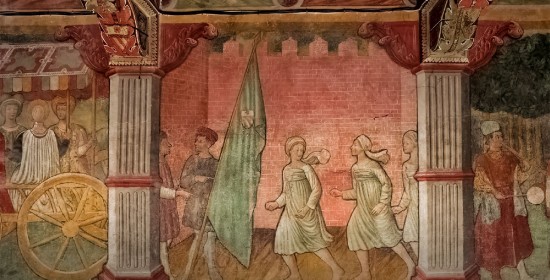
Buongiorno and welcome to RomeCabs, Rome’s top-rated tour company for private tours from Rome and Shore Excursions from Civitavecchia.
Bracciano Castle, a highly sought-after destination in the Roman countryside, takes center stage in several of our private tours. From the comprehensive Rome Town & Country and Countryside Splendor Tour to the captivating Medieval Magic Tour, Bracciano Castle takes center stage. Cruisers can also visit Bracciano Castle on our Countryside Pre-Cruise Tour and post-cruise tours from Civitavecchia to Bracciano, showcasing the castle's enduring charm across a range of fun-filled itineraries for land trippers and cruisers.
As you step into the grandeur of Bracciano Castle, echoes of history reveal the remarkable tales of three influential women who left an indelible mark on its historic halls. In this blog, we embark on a journey through time, exploring three key rooms that bear witness to the resilience, intelligence, and courage of Bartolomea Orsini, Felice delle Rovere, and Isabella de Medici.
These fascinating halls - The Armory, Hall of Felice della Rovere, and the Hall of the Orsini Frieze (previously known as Islabella’s Room) - encapsulate not just the grandeur of their times but also the extraordinary contributions and challenges these remarkable women faced in shaping the legacy of Bracciano Castle.
Join us on a captivating journey through history as we unveil stories of empowerment, resilience, and enduring legacies within this iconic fortress.
Powerful Women of Bracciano Castle:
Bartolomea Orsini, Felice delle Rovere, Isabella de Medici
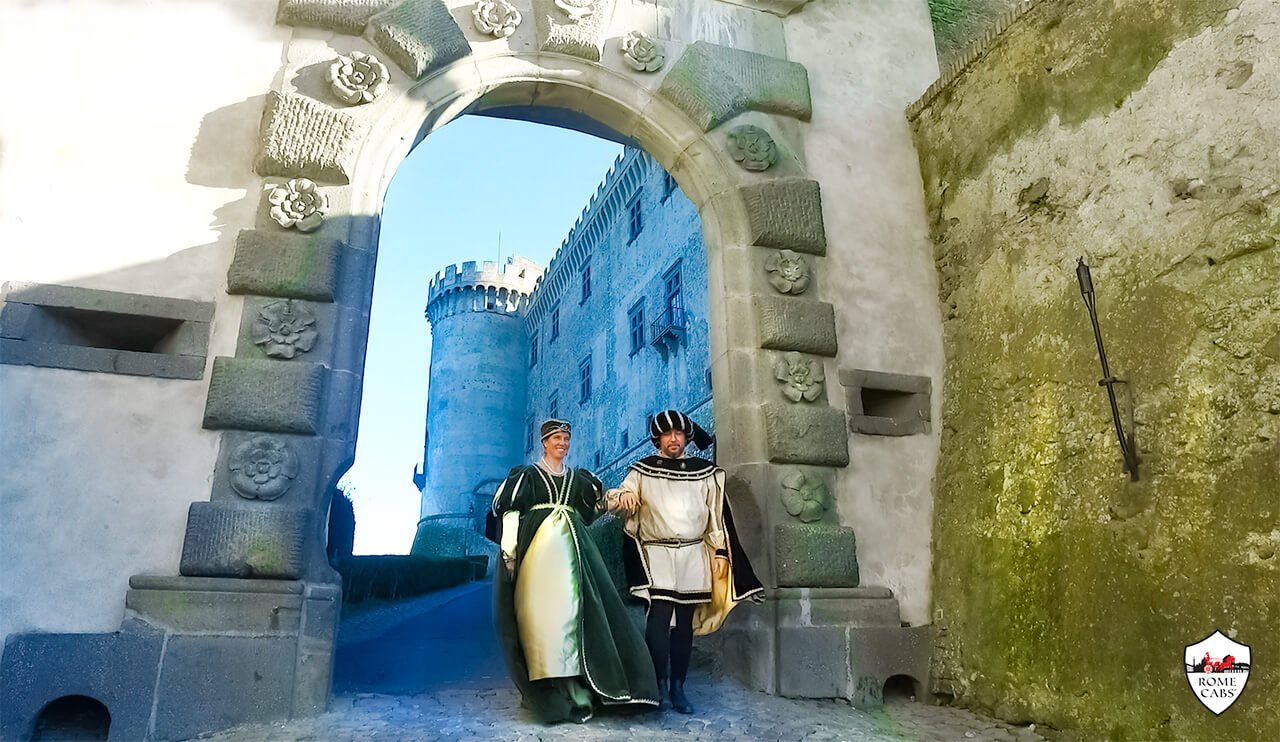
The Armory - Bracciano Castle Siege and the "Lady Warrior"
When you first set foot into the castle through the magnificent lard doors, you will have entered the vestibule.
Here, just to the right is the Armory, a symbol of the castle's perpetual preparedness for both defense and conflict. The arched entrance opens into a series of large chambers, some skillfully carved into the cliffside, lit by sunlight through strategically placed windows.
Originally conceived as the castle's guardhouse and garrison, these chambers were meticulously designed to house weaponry and ammunition stores. A cistern was also constructed in this area to collect rainwater that flowed into the courtyard.
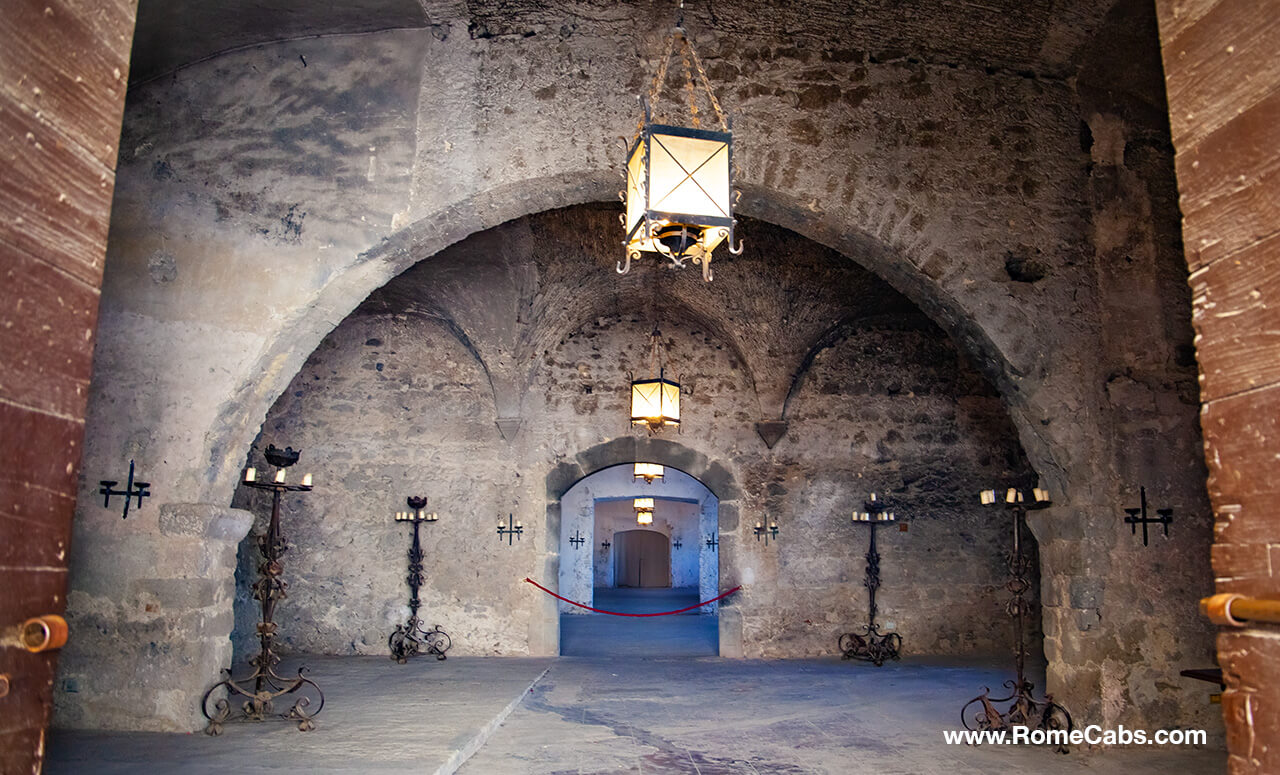
Equipped with cutting-edge arms of its time, including firearms and artillery, the castle stood fortified to repel potential enemy assaults. This preparedness of these defenses paid off in 1496 when the castle was sieged during the intense conflict involving the Orsini family, Pope Alexander VI (Rodrigo Borgia), and the King of Naples.
This tumultuous period unfolded with perilous political alliances, betrayal, the dramatic siege of Bracciano Castle, the tragic downfall of Gentil Virginio Orsini, and the bravery of Bartolomea Orsini (Gentil Virginio’s sister) whose valor and military acumen were instrumental in the successful defense of Bracciano Castle against the formidable Pope and the Borgia family.
Before we get to Bartolomea Orsini, here is the background story of the attack on Bracciano Castle and what brought it on.
Attack on Bracciano Castle and Tragedy of of Gentil Virginio Orsini
The assault on Bracciano Castle and the tragic fate of Gentil Virginio Orsini marked a tumultuous chapter in the Orsini family's history. As a condottiere (mercenary captain) in the service of the Kingdom of Naples and a Lord of Bracciano, Gentil Virginio's decision to extend hospitality to King Charles VIII of France during the French campaign in 1494 to topple the Kingdom of Naples had far-reaching consequences.
Seeing an opportunity for political and strategic gain, Gentil Virginio forged an alliance with King Charles VIII, offering the king shelter at Bracciano Castle and allowing French troops passage through Orsini territory towards Rome and Naples. This move, however, was perceived as a betrayal by Pope Alexander VI of the Borgia family and the King of Naples from the Aragonese dynasty.
Despite previous honors bestowed upon Gentil Virginio, including the Order of the Ermine and prestigious military appointments by the King of Naples, he found himself excommunicated by the Pope and an enemy of the Kingdom of Naples.
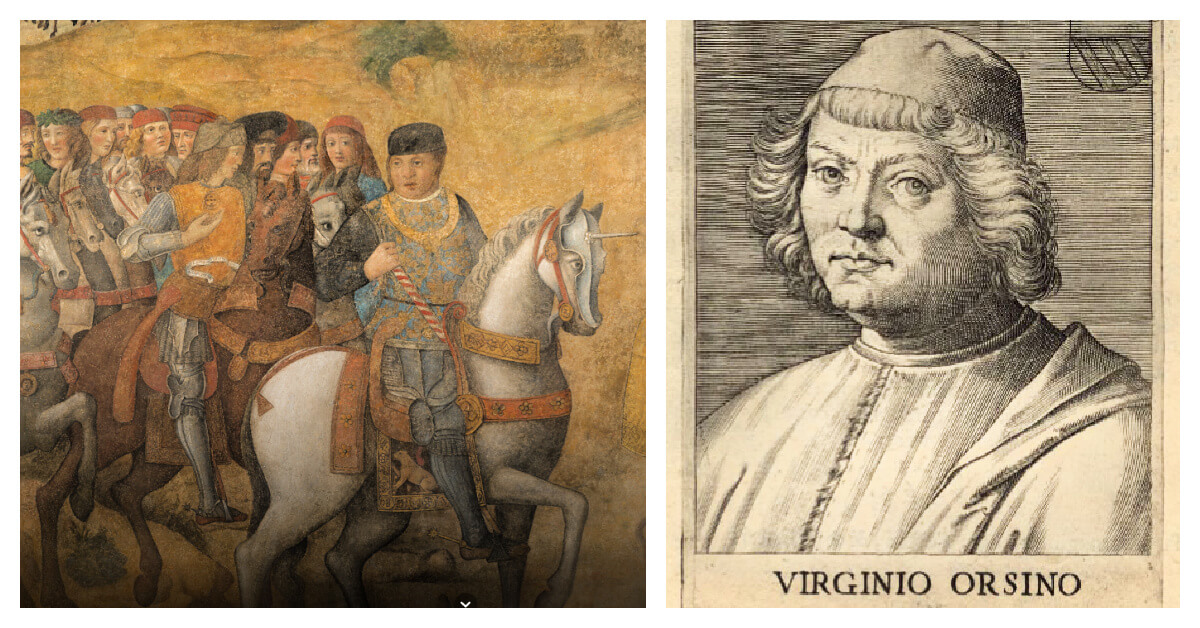
In the ensuing conflict, the Borgias launched an assault on the Orsini family's fortresses in Galeria, Sutri, Bassano, Campagnano, Anguillara, and Trevignano. Bracciano Castle, enduring a prolonged siege, stood as a formidable bastion against the papal onslaught.
As the Pope confiscated Orsini strongholds in the Papal States in favor of the Borgia family, Bracciano Castle stood resilient. With its impressive architecture, substantial water reservoir, and formidable defense measures rendered it impervious to conquest
Following the eventual defeat of the French forces, Virginio Orsini was captured, imprisoned in Castel dell'Ovo in Naples, and tragically passed away on January 8, 1497, potentially due to poisoning as a result of his alliance with the French King and his refusal to surrender his relatives to the papal army.
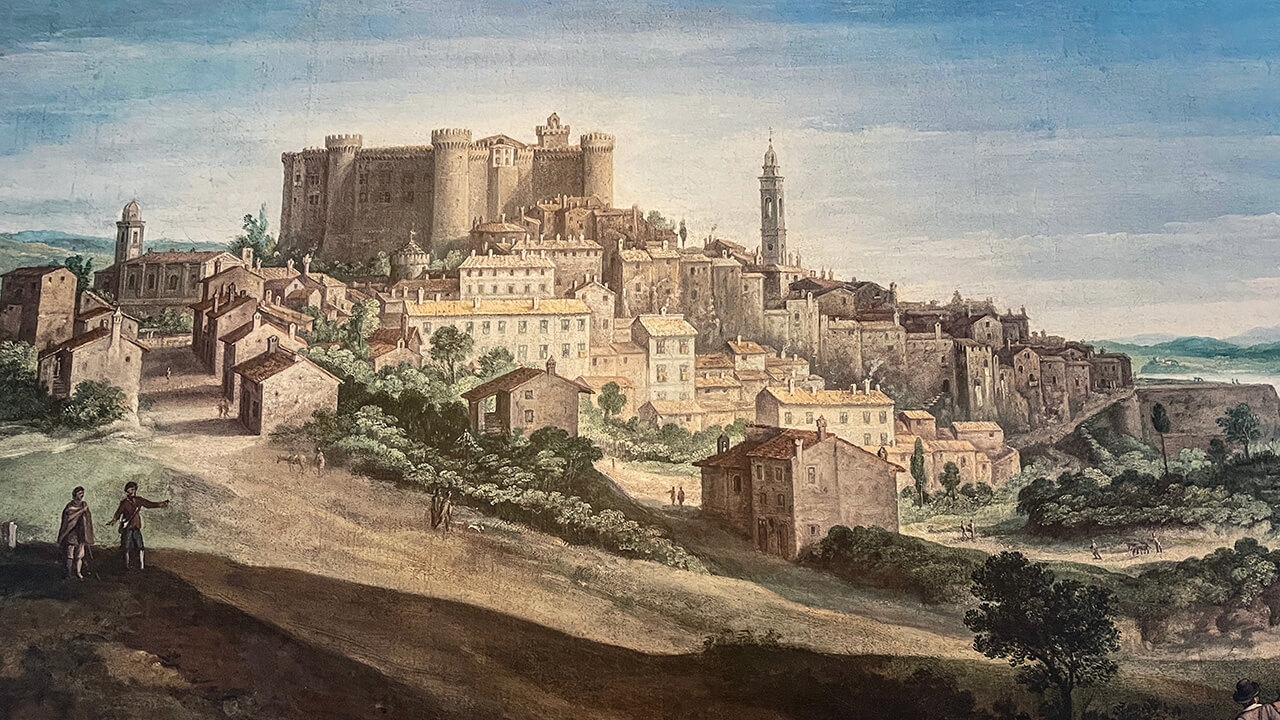
Bartolomea Orsini - Lady Warrior who held Bracciano Castle
Bartolomea Orsini's extraordinary courage and military prowess were truly exceptional, defying the norms of her era and placing her at the forefront of significant military and political engagements earning her the nickname of Lady Warrior (Gentil Donna Guerriera).
Amidst the siege of 1496 and the subsequent battle in 1497, Bracciano Castle emerged as the pivotal headquarters for the Orsini family. In the absence of Gentil Virginio, his brave sister, Bartolomea, took charge, demonstrating unwavering defense strategies with intelligence, bravery, and resourcefulness—a departure from the expected role of a woman in those times.
As her husband, Bartolomeo d'Alviano, was frequently away on military missions, Bartolomea assumed a leadership role, employing unconventional methods.
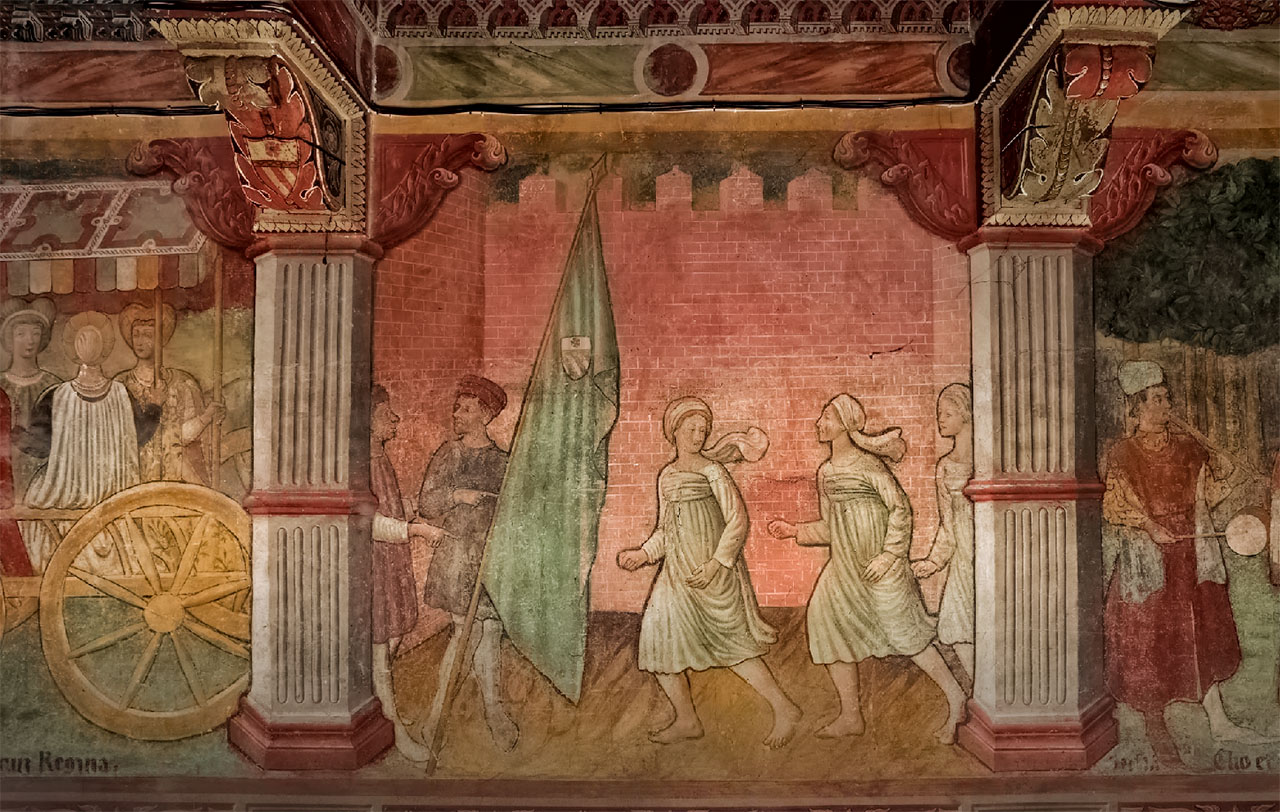
Gathering her brother's soldiers, who sought refuge from the Kingdom of Naples, she armed them with weapons and horses, repaired artillery, strengthened defenses, and equipped battlements with stones and fireworks for potential use against attackers. In an extraordinary display of initiative, she even trained local peasants in weaponry, assuming command of the fortress.
Meanwhile, her husband, Bartolomeo d'Alviano, engaged in guerrilla warfare, disrupting the enemy and working tirelessly to assemble an army for the liberation of Bracciano.
Historians noted, "From Rome, the Pope's troops were in the camp at Bracciano, in which was that Lady Bartolomea Orsini, sister of Mr. Virginio, with some people, and she was defending herself manfully".
Described by contemporaries as a courageous and benevolent noble figure, Bartolomea valiantly defended Bracciano, extending generous support to the soldiers both financially and by sharing her personal possessions. Her role and resilience in the face of adversity left an indelible mark on the historical narrative of Bracciano Castle.
Felice della Rovere - Bracciano Castle Matriarch and “Gubernatrix”
Hall of Felice della Rovere is dedicated to Felice della Rovere, the grandmother of Paolo Orsini. In one corner, near the fireplace, her portrait stands as a testament to her intriguing life.
Felice's life exemplified the intersection of noble lineage, political maneuvering, and cultural patronage that characterized the lives of prominent figures during the Renaissance.
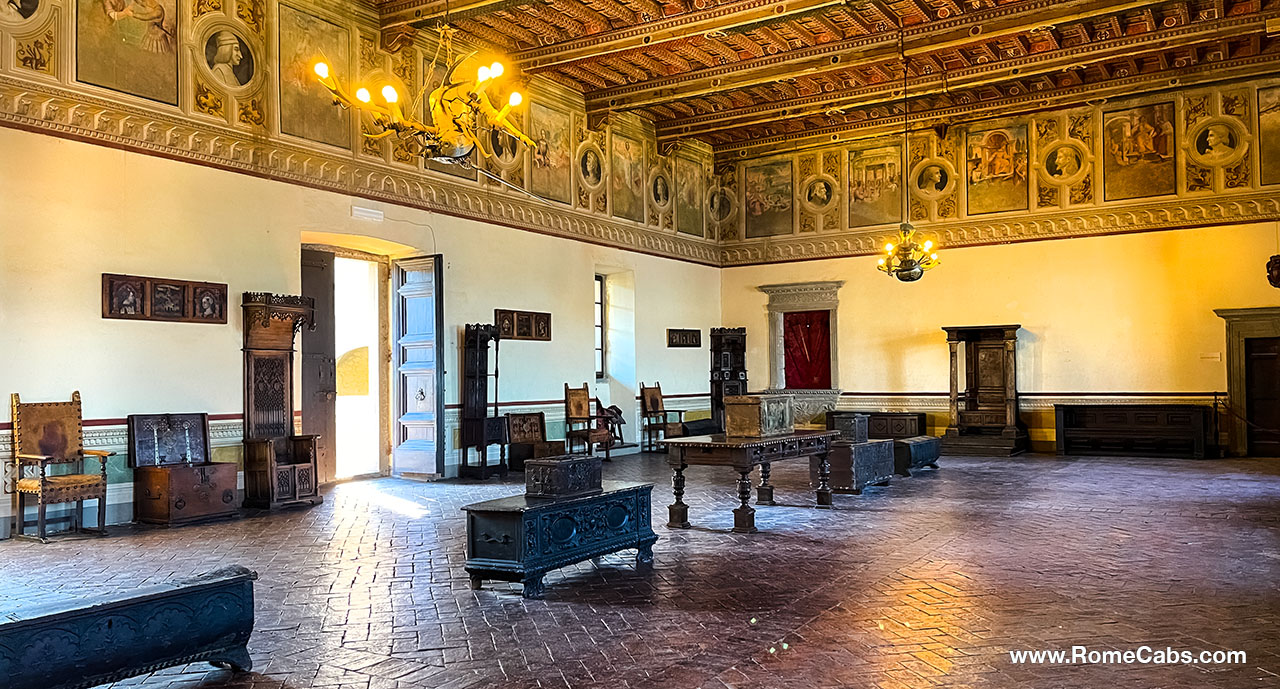
Born as the illegitimate daughter of Cardinal Giuliano della Rovere, who would later ascend to become Pope Julius II, Felice entered into marriage with Gian Giordano Orsini, the heir of Bracciano, as per her father's wishes when she was around 20 years old.
Growing up in the influential della Rovere family, Felice was characterized by her education, sharp intellect, and courage, enjoyed encounters with distinguished artists such as Leonardo da Vinci, Raphael, and Michelangelo, who were engaged in the creation of the Sistine Chapel ceiling under the patronage of Pope Julius II.
Following her father's death, Felice retained her influence within the Vatican even after her father's death, maintaining relationships with cardinals who later ascended to the papacy. Her political acumen and connections played a role in shaping the political landscape of the time.
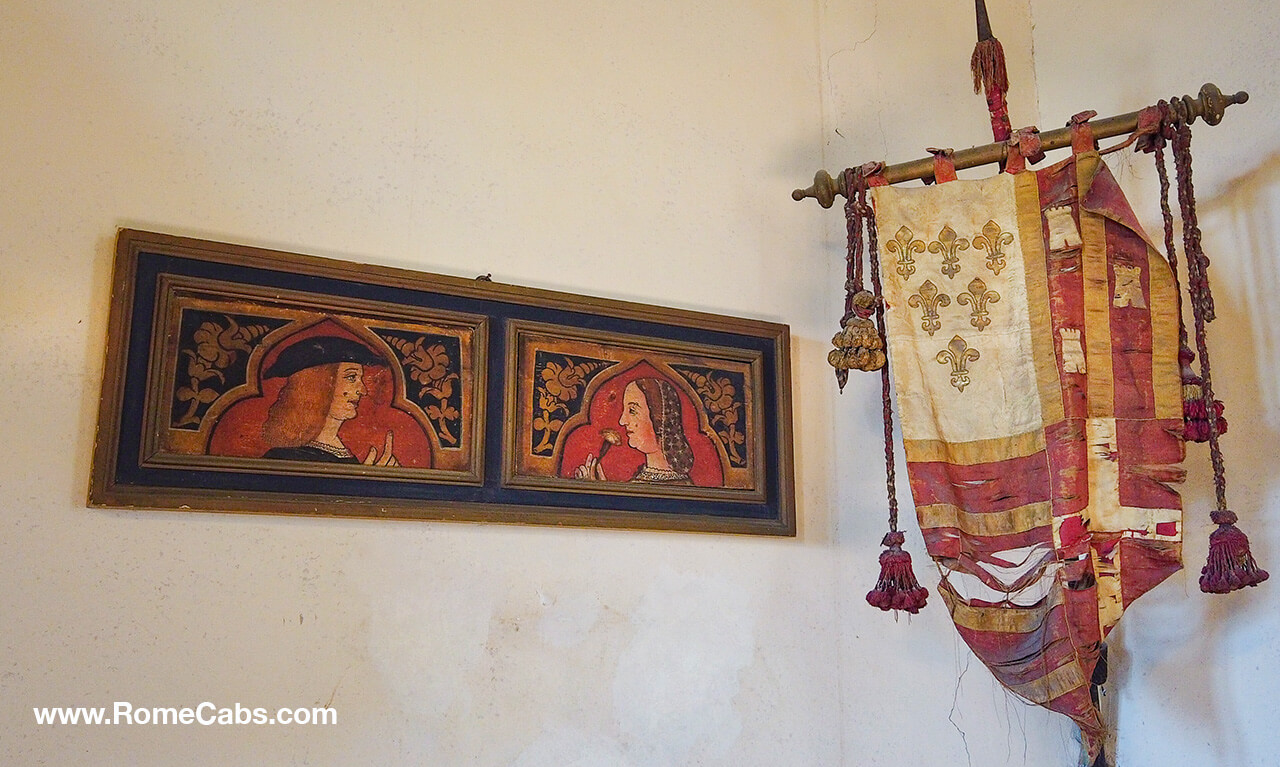
Upon her husband's death, Felice, now a widow, assumed the formidable role of governor (gubernatrix) of the extensive Orsini lands. This encompassed overseeing family matters, roads, castles, agriculture, state affairs, and jurisprudence. Despite the challenges of widowhood, she demonstrated resilience and adept governance.
Her passing at the age of 53 marked the end of a life dedicated to securing the legacy of the castle for her son, the future father of Paolo Giordano. Her contributions to the governance of the Orsini territories and her enduring influence within the Vatican added a significant chapter to her life's story.
Hall of the Orsini Frieze - Isabella de Medici Legends of Bracciano Castle
For a long time, the Hall of the Orsini Frieze (Sala del Fregio Orsini) was believed to belong to Isabella de Medici. It remains uncertain whether it served as her actual bedroom as Isabella resided primarily in Florence having assumed the responsibility of managing the family's affairs following her mother's death.
Isabella's safety was a paramount concern for her father, Cosimo de Medici, given the presence of anti-Medici dissidents in Rome. As a result, he deemed it too precarious for her to reside in Bracciano or any of the city's palaces, making Florence the preferred and safer location due to the political climate at the time.
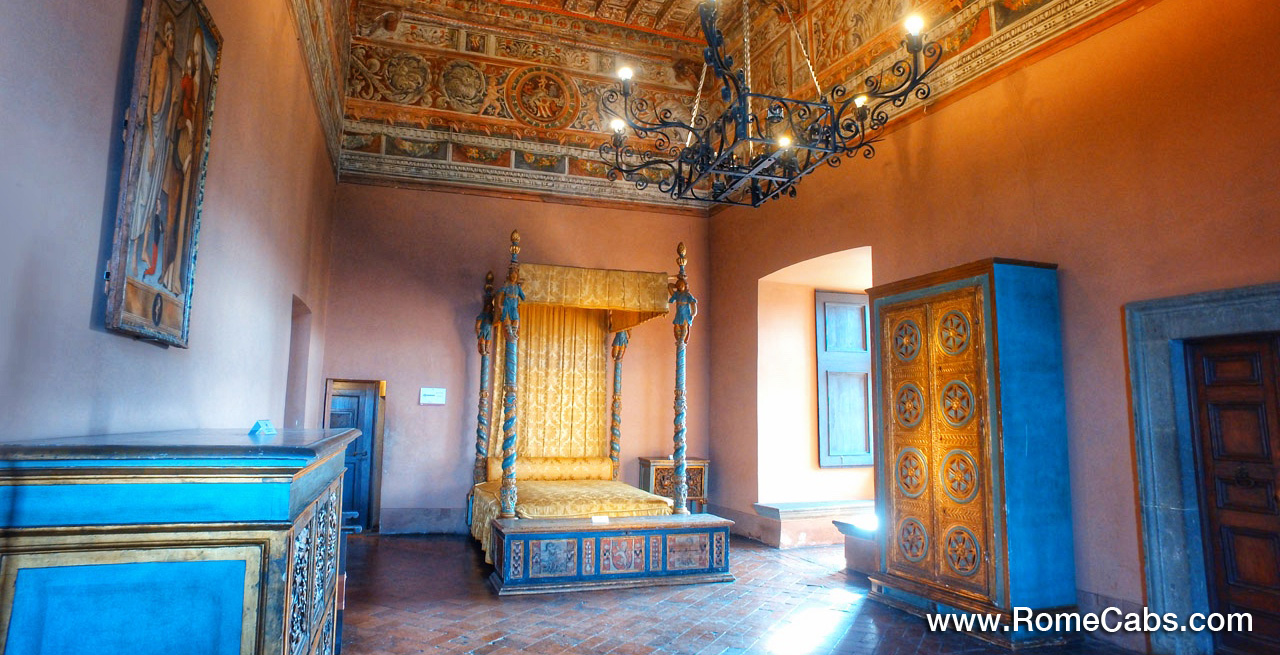
Despite these historical realities, Isabella de Medici and Paolo Giordano's legends of love, betrayal, and murder persisted for centuries
Scandalous tales suggested that Isabella conducted romantic affairs in this very chamber and, in a sinister turn, disposed of her lovers through a concealed trapdoor, casting them into a pit filled with blades and lime.
The story took a darker twist, alleging that her husband, Paolo Giordano, upon discovering her supposed infidelity, ended her life by strangulation with a ribbon. Isabella's death in 1576 at the age of 34 remained shrouded in mystery, sparking questions about whether it resulted from illness or foul play.
Amidst the intricate web of legends, a historical fact emerged that refuted claims of extramarital affairs and murder. Several hundred letters exchanged between Isabella and Paolo Giordano were discovered, unveiling a robust and affectionate marriage that cast doubt on the allegations of infidelity and murder.
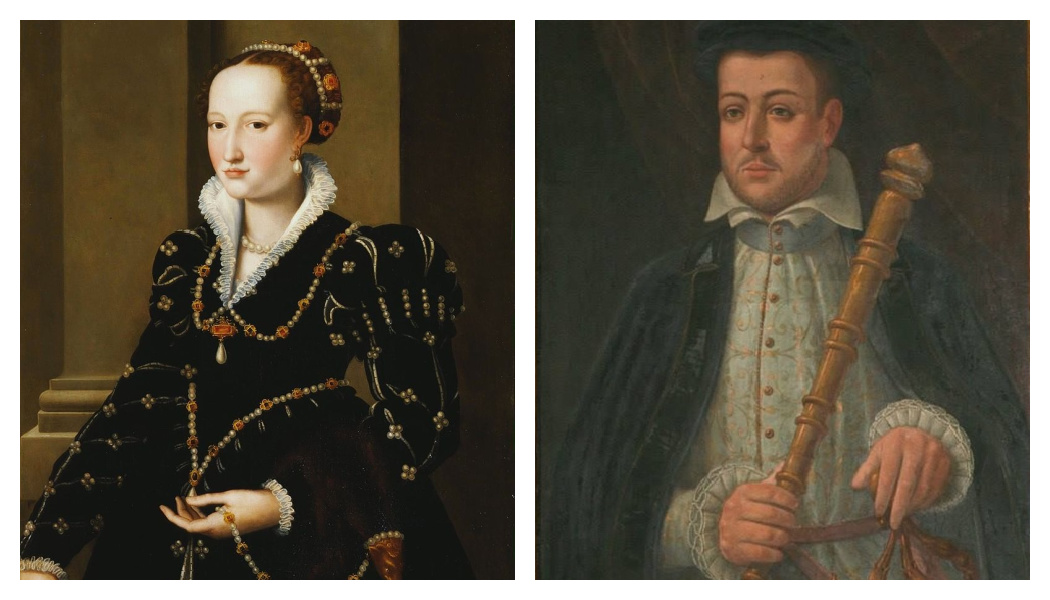
One of Paolo's letters to Isabella, found in this trove, reads:
“I adore you my beautiful, do believe that when I die, neither children, nor the State, nor friends, nor ladies, nor anything else will be remembered about me, except that I have loved you".
“I’ve only you. You, whom I loved since childhood”.
Contrary to the conventional narrative surrounding Isabella's demise at the hands of her husband, an extensive archive challenges this version of events in favor of severe illness leading to death.
Allusions to Isabella's health issues permeate her letters, with escalating concerns for her well-being emerging from 1574 onward suggesting an obstruction, possibly related to her kidneys, intestines, or uterus. Regardless of the specific ailment, Medici diplomacy worked actively to conceal the gravity of her condition, mirroring their approach during Cosimo's illness.
In August 1574, Isabella encountered her first severe hemorrhage followed by months of intermittent fever, leading doctors to prescribe laxatives and exercise, all documented in Isabella's letters.
By September 1575, Cardinal Ferdinando raised the prospect of dropsy for the first time—a condition marked by severe fluid accumulation in the body, often with disfiguring effects and fatal consequences in severe cases. References to Isabella's health struggles are dispersed throughout letters, with mounting concerns surfacing from 1574 onward.
Ambassador Ercole Cortile informed Alfonso d'Este in February 1575 that "Lady Isabella has been suffering from continuous fever for several days now, although it's somewhat slow, many don't think it's such a mild illness".
In March, Isabella herself wrote to her husband Paolo Giordano:
"I have a good day and a bad day. On a bad day, I stay in bed, and on a good day, I take walks because the doctors say exercise is necessary. My illness is all uppilation, which began in August and still afflicts me. They bled me with eighteen ounces of blood from my feet. Now they prescribe laxatives, and then they want me to go to the villa for exercise. I hope this helps me; this is why I haven't written because when I lower my head, I get such dizziness that it makes me lose my sight entirely, and that's why I've been neglectful".
Tragically, Isabella de' Medici passed away on July 16, 1576, in the Medici villa in Cerreto Guidi. In the days preceding her death, she and her husband had taken a walk, abruptly curtailed by her ailing health.
Her demise elicited profound sorrow from those acquainted with her, and her legacy endures as that of a woman distinguished by beauty, virtue, and generosity. Beyond the realms of legends and mysteries, Isabella's story encapsulates resilience, strength, and unswerving devotion to her family and loved ones.
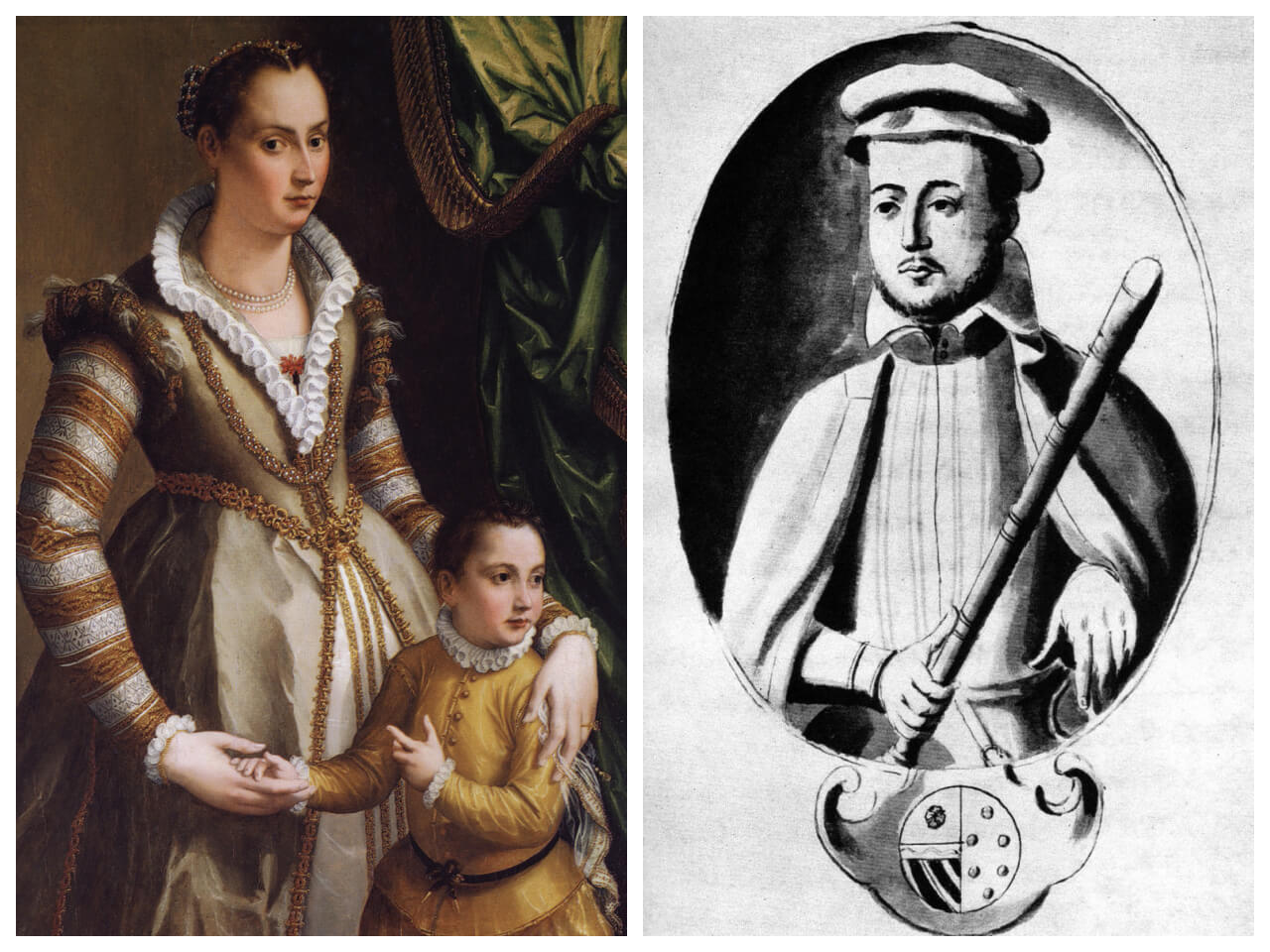
Isabella's besmirched reputation may have been exploited for political gain by adversaries of the de Medici family. Motivated by malicious intent and the diplomatic schemes of rival powers, these opponents sought to tarnish her legacy.
Over time, novelists and playwrights perpetuated the negative portrayal, weaving a narrative that insinuated Paolo Giordano murdered his wife to wed his mistress, Vittoria Accoramboni. In truth, as a widower, Paolo Giordano did encounter Vittoria Accoramboni and developed romantic feelings for this married woman—a story fraught with its own layers of betrayal, intrigue, and murder, surpassing all the narratives that surrounded Isabella.
The lives of Bartolomea Orsini, Felice della Rovere, and Isabella de Medici stand as powerful testaments to the indomitable spirit of women in the heart of Renaissance Italy. These remarkable women, each in her own right, contributed to the rich tapestry of history, navigating the complexities of politics, governance, and family responsibilities with grace and resilience.
As you explore the rooms of Bracciano Castle associated with these extraordinary women, you'll find echoes of their legacies etched into the stone walls. We invite you to delve into the captivating history of these powerful women and witness the grandeur of Bracciano Castle firsthand.
For an immersive experience, consider embarking on RomeCabs' Countryside Tours from Rome, Shore Excursions from Civitavecchia, Pre-Cruise Tours to Civitavecchia, or a Post Cruise Tour from Civitavecchia to Bracciano Castle. Let the charm of the castle and the tales of these remarkable women transport you to a bygone era of intrigue and elegance.
Thank you for reading our travel blog "Powerful Renaissance Women of Bracciano Castle: Bartolomea Orsini, Felice delle Rovere, Isabella de Medici" and for choosing RomeCabs for your best tours in Italy. We look forward to showing you beautiful places in bella Italia!
* Find us online also on:
